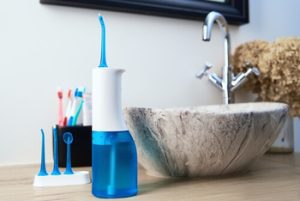Flossing is a key component of good oral hygiene, and many people now prefer water flossers over traditional string floss. If you’re using a Waterpik water flosser or a similar device, understanding when and how to replace your flosser tips is essential to keep your teeth and gums in top condition. In this guide, we’ll explore the various types of water flosser tips, the benefits of regular replacement, and tips on how to use them effectively. Let’s jump in and discover how you can maintain a healthy, sparkling smile!
Why Should You Replace Your Water Flosser Tips?
Water flossers are a great product for improving oral health, but like anything, their effectiveness can diminish over time. The water flosser tips do much of the work by directing water between your teeth and along your gumline to remove debris and bacteria. Regular replacement of these tips is essential because:
- Bacteria Buildup: Over time, flosser tips can harbour bacteria, which could affect your oral health. Replacing them ensures your water flosser stays hygienic and effective.
- Diminished Flow: With prolonged use, water flosser tips can wear down, reducing water pressure and the ability to clean deep between your teeth.
- Enhanced Cleaning: Fresh tips are more effective at removing debris and bacteria from beneath your gumline, keeping your gums and teeth healthy.
How Often Should You Replace Water Flosser Tips?
Replacement timelines can vary depending on how frequently you use your water flosser and the type of tip you have. As a rule of thumb:
- Classic Jet Tip: Replace every six months. This tip is perfect for general use and effectively cleans deep between teeth and along the gumline for a thorough clean.
- Orthodontic Tip: For those with braces or other dental appliances, this tip should be replaced every three months. Its tapered brush is designed to remove plaque and food particles from around braces, keeping your mouth fresh and healthy.
- Toothbrush Tip: This is a hybrid tip that combines brushing with flossing. It should be replaced every three months, just like a regular toothbrush.
- Tongue Cleaner: Replace this tip every six months. It removes bacteria from the tongue, helping to keep your breath fresh.
Effective Water Flosser Use: Simple Tips for a Deep Clean
Proper usage of your water flosser is just as important as replacing the tips. Here are some simple tips to help you maximise the benefits:
- Start with Low Pressure: If you’re new to using a water flosser, start with a low-pressure setting and gradually increase it as your gums adjust. This ensures a comfortable experience while still providing a thorough clean.
- Aim at the Gumline: Direct the water stream towards your gumline rather than at your teeth. This is where most plaque and bacteria accumulate, and targeting it is crucial for improving gum health.
- Use Warm Water: For added comfort, fill the flosser’s reservoir with warm water. This can help if you have sensitive gums or teeth.
- Follow a Routine: Just like brushing, it’s essential to follow a consistent pattern when using your flosser. Begin at the back of your mouth and work your way forward to ensure you cover all areas, especially the hard-to-reach spots.
Understanding Water Flosser Tips and Their Functions
Different water flosser tips are designed for various purposes. Choosing the right one can make all the difference in your oral health routine. Here’s a breakdown of the most common types:
- Classic Jet Tip: The standard tip that comes with most water flossers. It’s perfect for everyday flossing and provides a thorough clean between teeth and beneath the gumline.
- Orthodontic Tip: Specifically designed for people with braces, this tip has a tapered brush that can effectively clean around brackets and wires, removing food debris and plaque that regular brushing might miss.
- Toothbrush Tip: This tip allows you to brush and floss simultaneously. Shaped like a traditional toothbrush, it helps you multitask while still delivering the deep cleaning benefits of water flossing.
- Tongue Cleaner: Shaped like a small spoon, the tongue cleaner removes bacteria from the surface of the tongue, keeping your breath fresh and your mouth clean.
How to Replace Your Water Flosser Tips
Replacing your water flosser tips is a straightforward process. Here’s how to do it in just a few steps:
- Turn Off the Device: Always ensure your water flosser is powered off and unplugged before removing or inserting tips.
- Remove the Old Tip: Press the release button (usually located on the handle) to eject the current tip. Gently pull it out.
- Insert the New Tip: Take your new tip and slide it into the slot until you hear a click, ensuring it’s firmly in place.
- Check the Water Flow: Once the new tip is in place, run the flosser briefly to check the water pressure and ensure everything is functioning properly.
Maintaining Your Water Flosser for Long-Term Use
Aside from replacing the tips, taking care of your water flosser is crucial for ensuring its longevity. Here’s how to keep it running smoothly:
- Clean the Reservoir: Bacteria can grow inside the water reservoir if it’s not cleaned regularly. Make it a habit to wash the reservoir with warm, soapy water and rinse thoroughly.
- Use Distilled Water: If you live in an area with hard water, consider using distilled water to avoid mineral buildup inside the device.
- Replace Filters: Some water flossers come with filters. Check your user manual to see if yours does, and replace them as needed to maintain optimal water quality.
- Check for Wear and Tear: Over time, parts like the handle, hose, or reservoir may show signs of wear. If you notice cracks, leaks, or reduced water flow, it might be time to replace the part or contact the manufacturer for assistance.
Common Questions About Water Flosser Tips
If you’re still unsure about your water flosser or its tips, here are some common questions and answers:
- How do I know if my tip is worn out? A decrease in water pressure or a weaker flow may indicate that it’s time to replace your tip.
- Can I use toothpaste with my water flosser? No, toothpaste can clog the device. Instead, use mouthwash or specific solutions recommended by the manufacturer.
- Are all tips compatible with all water flossers? Not necessarily. Always check the packaging or product manual to ensure the tips are compatible with your device.
Conclusion: Keeping Your Smile Bright and Healthy
Whether you’re new to water flossing or have been using a Waterpik water flosser for years, keeping your tips fresh and clean is vital for maintaining excellent oral health. By following these water flosser replacement tips, you’ll ensure your device remains effective, helping you achieve a cleaner, healthier smile. Regularly replacing the tips, maintaining the device, and using it correctly will make your flossing routine easier and more enjoyable.
If you have more questions or need help selecting the right replacement tips, don’t hesitate to contact Infinity Dental Care at (02) 9159 6237 . We’re here to help you keep your oral health in top condition!
References:
WebMD. (n.d.). What is a Waterpik? WebMD. https://www.webmd.com/oral-health/what-is-waterpik
Colgate. (n.d.). Tongue bacteria: What’s healthy? Colgate Oral Care Center. https://www.colgate.com/en-in/oral-health/adult-oral-care/tongue-bacteria-whats-healthy
Waterpik. (n.d.). How to floss with braces. Waterpik. https://www.waterpik.com/edu/braces-orthodontics/how-to-floss-with-braces/




